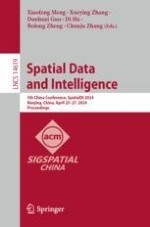2024 | Buch
Spatial Data and Intelligence
5th China Conference, SpatialDI 2024, Nanjing, China, April 25–27, 2024, Proceedings
herausgegeben von: Xiaofeng Meng, Xueying Zhang, Danhuai Guo, Di Hu, Bolong Zheng, Chunju Zhang
Verlag: Springer Nature Singapore
Buchreihe : Lecture Notes in Computer Science
